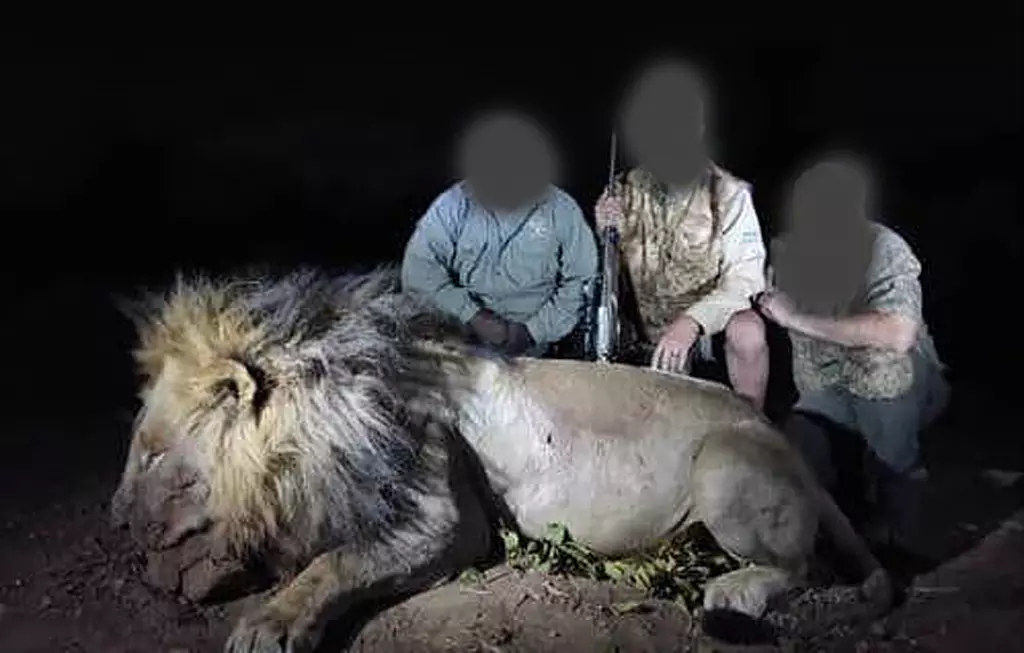GPS-collared lion lured from Zimbabwe’s Hwange National Park and killed despite being part of critical Oxford University conservation study
WASHINGTON, D.C. — The Center for a Humane Economy today condemned the killing of Blondie, a five-year-old African lion lured out of Zimbabwe’s Hwange National Park and killed by a trophy hunter reportedly from Ashland, Ohio. The lion was wearing a GPS tracking collar and was part of an Oxford University Wildlife Conservation Research Unit study supporting conservation efforts of free-roaming lions. The shooting happened in June.
Blondie was the dominant male of a pride including three adult females and 10 cubs. His death not only removes an important male from the ecosystem but also jeopardizes ongoing scientific research aimed at protecting Africa’s dwindling wild lion populations. Listed as threatened with extinction under the U.S. Endangered Species Act, African lions in Zimbabwe continued to be threatened by American trophy hunters.

As a “threatened” subspecies, imports of live lions and sport-hunted trophies require a special ESA 4(d) permit, signaling that the action “enhances the survival of the species.”
“Once again, we witness the senseless hunting of a magnificent animal for nothing more than self-gratification,” said Wayne Pacelle, president of the Center for a Humane Economy. “The idea that shooting this important male lion ‘enhances the survival of the species’ is laughable. The United States should not allow trophy hunters to import sport-hunted trophies of threatened species into our country. This killing was clearly detrimental to the well-being of the highly vulnerable lion population in southern Africa.”
Simon Espley, CEO of safari experts Africa Geographic, which sponsored Blondie’s collar, expressed his frustration to reporters. “That Blondie’s prominent collar did not prevent him from being offered to a hunting client, confirms the stark reality that no lion is safe from trophy hunting guns. He (Blondie) was a breeding male in his prime, making a mockery of the ethics that ZPGA [Zimbabwe Professional Guides Association] regularly espouses and the repeated claims that trophy hunters only target old, non-breeding males.”
The incident echoes the 2015 killing of Cecil, the beloved and iconic male African lion, in the same area in Zimbabwe, which sparked international outrage and calls for stricter protections of Africa’s lions. Cecil was also killed by an American trophy hunter.
“The killing of Blondie, like Cecil before him, demonstrates the utter disregard trophy hunters have for conservation science and wildlife protection,” said Jennifer Skiff, director of international programs for the Center for a Humane Economy. “This shameful industry continues to target the very animals that researchers are working to save. The killing of collared research animals represents a particular betrayal of conservation efforts.”
The Center for a Humane Economy has filed multiple Freedom of Information Act (FOIA) requests over the past several years seeking information from the U.S. Fish and Wildlife Service (USFWS) regarding import permits for African lion trophies. These requests have gone unanswered by the federal agency, raising questions about transparency in the trophy import process and the agency’s commitment to lion conservation.
“The American people deserve to know how many lion trophies are being imported into our country and by whom,” said Pacelle. “The USFWS’s failure to respond to our FOIA requests suggests they may be hiding information that would further expose the ongoing adverse impact of American trophy hunters on Africa’s threatened and endangered wildlife.”
African lion populations have declined by approximately 43% over the past two decades, with the International Union for Conservation of Nature (IUCN) estimating between 23-39,000 lions remaining in the wild, listing the species as vulnerable. Trophy hunting continues to target the largest, healthiest males – precisely the animals most crucial for species conservation and genetic diversity.

